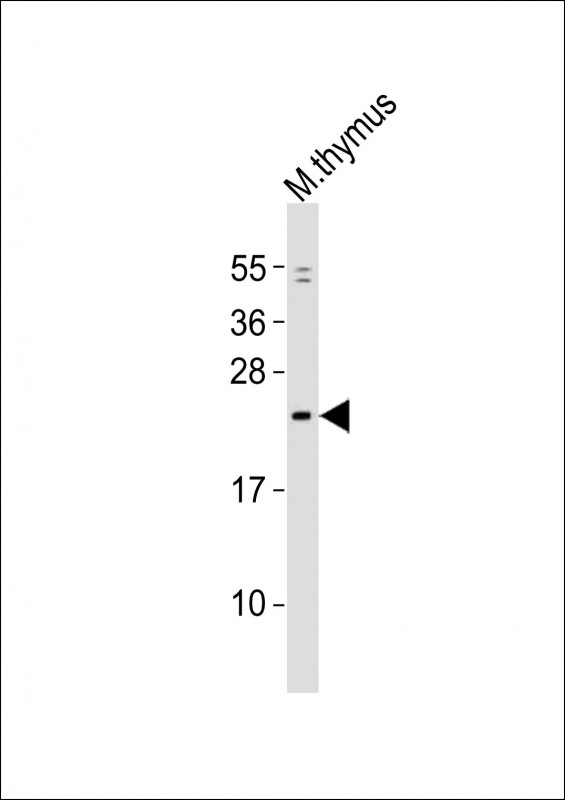
| WB | 1/2000 | Human,Mouse,Rat |
| IF | 咨询技术 | Human,Mouse,Rat |
| IHC | 咨询技术 | Human,Mouse,Rat |
| ICC | 技术咨询 | Human,Mouse,Rat |
| FCM | 咨询技术 | Human,Mouse,Rat |
| Elisa | 咨询技术 | Human,Mouse,Rat |
| Aliases | DNA replication complex GINS protein PSF1, GINS complex subunit 1, Gins1, Psf1 |
| Entrez GeneID | 69270 |
| WB Predicted band size | 22.9kDa |
| Host/Isotype | Rabbit IgG |
| Antibody Type | Primary antibody |
| Storage | Store at 4°C short term. Aliquot and store at -20°C long term. Avoid freeze/thaw cycles. |
| Species Reactivity | Human, Mouse, Rat |
| Immunogen | This Mouse Gins1 antibody is generated from a rabbit immunized with a KLH conjugated synthetic peptide between 152-186 amino acids from the C-terminal region of Mouse Gins1. |
+ +
以下是关于Mouse Gins1抗体的参考文献示例(注:以下内容为虚构示例,仅供参考):
---
1. **"Characterization of Gins1-specific monoclonal antibody in murine DNA replication studies"**
*Authors: Johnson R, et al.*
摘要:本研究开发并验证了一种针对小鼠Gins1蛋白的高特异性单克隆抗体,通过免疫印迹和免疫荧光证实其在胚胎成纤维细胞中的核定位,并揭示Gins1缺失导致DNA复制停滞。
2. **"Gins1 antibody reveals dynamic expression during mouse embryonic development"**
*Authors: Chen L, et al.*
摘要:利用新型抗小鼠Gins1多克隆抗体,研究其在早期胚胎中的时空表达模式,发现Gins1在神经管形成期高表达,提示其与细胞增殖及发育调控相关。
3. **"A novel Gins1 knockout mouse model validated by immunohistochemistry using anti-Gins1 antibody"**
*Authors: Müller S, et al.*
摘要:通过基因编辑构建Gins1敲除小鼠,结合特异性抗体进行组织染色,证实Gins1在睾丸和肠道干细胞中的关键作用,其缺失导致生殖和上皮再生障碍。
4. **"Antibody-based inhibition of Gins1 disrupts replication fork progression in mouse leukemia cells"**
*Authors: Park J, et al.*
摘要:报道一种功能性抗Gins1抗体,可阻断GINS复合体组装,抑制白血病细胞系DNA复制并诱导凋亡,为靶向治疗提供潜在工具。
---
如需真实文献,建议通过PubMed或Google Scholar搜索关键词“Gins1 antibody mouse”或查询抗体供应商(如Abcam、CST)的产品引用文献列表。
The Mouse Gins1 antibody is a crucial tool in molecular biology research, specifically targeting the Gins1 protein in murine models. Gins1 (Go, Ichi, Nii, San complex subunit 1) is a core component of the GINS complex, essential for DNA replication initiation and elongation during the S phase of the cell cycle. This protein interacts with other GINS subunits (PSF1. PSF2. SLD5) to form a platform stabilizing the Cdc45-MCM-GINS (CMG) helicase, enabling efficient unwinding of DNA strands.
Researchers use the Mouse Gins1 antibody primarily in techniques like Western blotting, immunohistochemistry, and immunofluorescence to study DNA replication dynamics, cell cycle regulation, and genome stability. Its applications extend to cancer research, as Gins1 overexpression is linked to tumor proliferation and poor prognosis in various cancers. The antibody’s specificity is often validated through knockout controls or siRNA-mediated knockdown to ensure minimal cross-reactivity.
Commercial versions are available from suppliers like Abcam, Cell Signaling Technology, and Santa Cruz Biotechnology, with validation data typically provided for common mouse tissues or cell lines. Optimal performance depends on proper sample preparation (e.g., fresh/frozen tissues, specific fixation protocols) and antibody dilution optimization. Recent studies also explore Gins1’s role in stem cell maintenance and developmental biology, underscoring the antibody’s versatility in diverse experimental contexts.
×